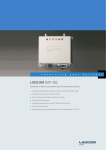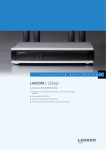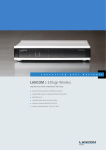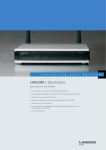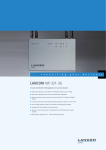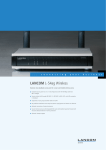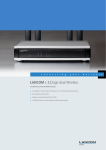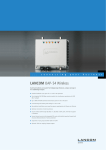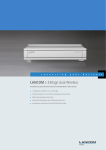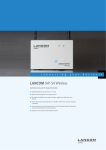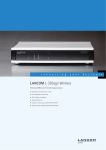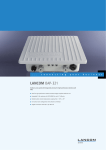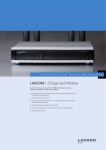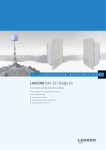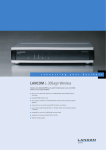Download Lancom Systems IAP-321
Transcript
. . .
c o n n e c t i n g
y o u r
LANCOM IAP-321
Professional 802.11n access point with full- metal housing for demanding
applications
쮿 Dual- band access point with 2 x 2 MIMO and Gigabit Ethernet
쮿 Discreet design with IP50 durability
쮿 Intelligent anti- theft protection, ideal for highly frequented public buildings
쮿 Extended temperature range from - 20°C to +50°C, suitable even for harsh environments
쮿 Flexible power supply: 12 V power supply unit, universal power adapter, or PoE
쮿 Incl. mounting materials for wall, mast or top- hat rail installation
b u s i n e s s
The LANCOM IAP- 321 meets the highest standards both in wireless LAN performance and in terms of housing design. This dual- band 802.11n access point features MIMO
technology for high data rates. The support of VLAN and Multi- SSID makes it the right choice for virtualized networks. The LANCOM IAP- 321 is a true all- rounder: It has a fullmetal housing of subdued design and fitted with an intelligent Kensington lock for anti- theft protection. This makes it ideal for highly frequented areas such as hotels, universities,
or public buildings. The LANCOM IAP- 321 can also be employed in areas such as warehouses: The unit is dust- proof to the IP- 50 protection rating and operates in a temperature
range from - 20°C to +50°C. In combination with the three options for mounting and the three different power supply types, this device offers unparalleled flexibility.
More Security.
LANCOM guarantees you communication with the highest standards of security with an extensive range of encryption and authentication mechanisms. With the aid of Multi- SSID
and protocol filters, up to 8 different user groups can each be assigned different levels of security. VLAN technology, matured quality- of- service functions and bandwidth limitation
enable the reliable transmission of video and multimedia data streams.
More Management.
The free LANCOM Management System LCMS allows the status and functions of the LANCOM IAP 321 and the entire network to be controlled at all times. For example, it is possible
to check whether the access points are transmitting and, if so, on which channels, how much data each one is sending, which clients are logged in and where, what encryption
method is active, and a whole lot more. The LANCOM Management System also helps you to optimize performance over wireless bridges.
For larger installations, the LANCOM IAP- 321 can be completely controlled by the LANCOM WLAN Controller. Settings for wireless, encryption, or access- control lists can be grouped
into device configurations, which are then executed for multiple access points in one easy move. Access points are commissioned and RF optimization carried out automatically.
Changes are transmitted to all of the devices automatically and subsequently monitored.
The LANCOM IAP- 321 also supports TACACS+. Using the AAA protocol ("authentication, authorization, accounting") it is possible to track all activities relating to the configuration
of the access point.
More Reliability for the Future.
From the very start, LANCOM products are designed for a product life of several years. They are equipped with hardware dimensioned for the future. Even reaching back to older
product generations, updates to the LANCOM Operating System–LCOS–are available several times a year, free of charge and offering major features. LANCOM offers unbeatable
protection of your investment!
LANCOM IAP-321
Scope of features: as of LCOS version 8.5x
WLAN
Frequency band 2.4 GHz or 5 GHz
2400- 2483.5 MHz (ISM) or 5150- 5825 MHz (depending on country- specific restrictions)
Data rates 802.11b/g
54 Mbps to IEEE 802.11g (fallback to 48, 36 , 24, 18, 12, 9, 6 Mbps, Automatic Rate Selection) compatible to IEEE 802.11b (11,
5.5, 2, 1 Mbps, Automatic Rate Selection), 802.11 b/g compatibility mode or pure g or pure b
Data rates 802.11a/ h
54 Mbps (fallback to 48, 36 , 24, 18, 12, 9, 6 Mbps, Automatic Rate Selection), fully compatible with TPC (adjustable power
output) and DFS (automatic channel selection, radar detection) according to ETSI EN 301 893 V.1.5.1., EN 302 502
Data rates 802.11n
300 Mbps according to IEEE 802.11n with MSC15 (Fallback to 6,5 Mbps with MSC0)
Range (outdoor / P2P)
More than 20 km in 5 GHz. See our LANCOM Antenna Distance Calculator under www.lancom.de
Output power at radio module, 5 GHz
802.11a/h: 17 dBm @ 6 bis 24 Mbit/s, 15 dBm @ 36 Mbit/s, 13 dBm @ 54 Mbit/s,
802.11n: 17 dBm @ 6,5/13/30 Mbit/s (MCS0/8), 13 dBm @ 65/130/300 Mbit/s (MCS7/15)
Minimum transmission power
Transmission power reduction in software in 1 dB steps to min. 0.5 dBm
Receiver sensitivity 2.4 GHz
802.11b: - 89 dBm @ 11 Mbit/s, - 94 dBm @ 1 Mbit/s
802.11g: - 93 dBm @ 6 Mbit/s, - 79 dBm @ 54 Mbit/s
802.11n: - 93 dBm @6,5 Mbit/s (MCS0/8), - 75 dBm @ 65 Mbit/s (MCS7/15)
Receiver sensitivity 5 GHz
802.11a/h: - 93 dBm @ 6Mbit/s, - 75 dBm @ 54 Mbit/s
802.11n: - 93 dBm @ 6,5 Mbit/s (MCS0/8), - 71 dBm @ 65 Mbit/s (MCS7/15)
Radio channels 2.4 GHz
Up to 13 channels, max. 3 non- overlapping (2.4 GHz band)
Radio channels 5 GHz
Up to 26 non- overlapping channels (available channels and further obligations such as automatic DFS dynamic channel
selection depending on national regulation)
Roaming
Seamless handover between radio cells, IAPP support with optional restriction to an ARF context, IEEE 802.11d support
WPA2 fast roaming
Pre- authentication and PMK caching for fast roaming
Fast client roaming
With background scanning, moving LANCOM 'client mode' access points pre- authenticate to alternative access points which
offer a better signal before Roaming fails
VLAN
VLAN ID definable per interface, WLAN SSID, point- to- point connection and routing context (4094 IDs) IEEE 802.1q
Dynamic VLAN assignment
Dynamic VLAN assignment for target user groups based on MAC addresses, BSSID or SSID by means of external RADIUS server.
Q- in- Q tagging
Support of layered 802.1q VLANs (double tagging)
Multi- SSID
Simultaneous use of up to 8 independent WLAN networks per WLAN interface
IGMP snooping
Support for Internet Group Management Protocol (IGMP) in the WLAN bridge for WLAN SSIDs and LAN interfaces for specific
switching of multicast packets (devices with integrated WLAN only). Automated detection of multicast groups. Configurable
action for multicast packets without registration. Configuration of static multicast group members per VLAN ID. Configuration
of query simulation for multicast membership per VLAN ID
Security
IEEE 802.11i / WPA2 with passphrase or 802.1x and hardware- accelerated AES, closed network, WEP64, WEP128, WEP152,
user authentication, 802.1x /EAP, LEPS, WPA1/TKIP
RADIUS server
Integrated RADIUS server for MAC address list management
EAP server
Integrated EAP server for authentication of 802.1x clients via EAP- TLS, EAP- TTLS, PEAP, MSCHAP or MSCHAPv2
Quality of Service
Prioritization according to Wireless Multimedia Extensions (WME, subset of IEEE 802.11e)
U- APSD/WMM Power Save
Extension of power saving according to IEEE 802.11e by Unscheduled Automatic Power Save Delivery (equivalent to WMM Power
Save). U- APSD supports the automatic switch of clients to a doze mode. Increasmed battery lifetime for telephone calls over
VoWLAN (Voice over WLAN)
Bandwidth limitation
Maximum transmit and receive rates and an individual VLAN ID can be assigned to each WLAN client (MAC address)
Broken link detection
If the link of a chosen LAN interface breaks down, a WLAN module can be deactivated to let the associated clients search for a
new base station
Background scanning
Detection of rogue AP's and the channel information for all WLAN channels during normal AP operation.
The Background Scan Time Interval defines the time slots in which an AP or Router searches for a foreign WLAN network in its
vicinity. The time interval can be specified in either milliseconds, seconds, minutes, hours or days
Client detection
Rogue WLAN client detection based on probe requests
802.1x supplicant
Authentication of an access point in WLAN client mode at another access point via 802.1x (EAP- TLS, EAP- TTLS and PEAP)
Layer- 3 Tunneling
Layer- 3 Tunneling in conformity with the CAPWAP standard allows the bridging of WLANs per SSID to a separate IP subnet.
Layer- 2 packets are encapsulated in Layer- 3 tunnels and transported to a LANCOM WLAN controller. By doing this the access
point is independent of the present infrastructure of the network. Possible applications are roaming without changing the IP
address and compounding SSIDs without using VLANs.
LANCOM IAP-321
Scope of features: as of LCOS version 8.5x
IEEE 802.11n Features
MIMO
MIMO technology is a technique which uses multiple transmitters to deliver multiple data streams via different spatial channels.
Depending on the existing RF conditions the throughput is doubled with MIMO technology
40 MHz Channels
Two adjacent 20 MHz channels are combined to create a single 40 MHz channel. Depending on the existing RF Conditions
channel bonding doubles the throughput.
MAC Aggregation and Block
Acknowledgement
MAC Aggregation increase the 802.11 MAC efficiency by combining MAC data frames and sending it out with a single header.
The receiver acknowledges the combined MAC frame with a Block Acknowledgement. Depending on existing RF conditions, this
technique improves throughput by up to 20%.
Short Guard Interval
The guard interval is the time between OFDM symbols in the air. 802.11n gives the option for a shorter 400 nsec guard interval
compared to the legacy 800 nsec guard interval. Under ideal RF conditions this increases the throughput by upto 10%
BFWA*
Support for Broadband Fixed Wireless Access in 5.8 GHz band with up to 4 Watt EIRP for WLAN point- to- point links according
to the national regulations of your country, special antennas required
*) Note
The use of BFWA is subject to country specific regulation
WLAN operating modes
WLAN access point
Infrastructure mode (autonomous operation or managed by LANCOM WLAN Controller)
WLAN bridge
Point- to- multipoint connection of up to 7 Ethernet LANs (mixed operation optional), broken link detection, blind mode, supports
VLAN
When configuring Pt- to- Pt links, pre- configured names can be used as an alternative to MAC Adresses for creating a link. Rapid
spanning- tree protocol to support redundant routes in Ethernet networks
WLAN router
Use of the LAN connector for simultaneous DSL over LAN, IP router, NAT/Reverse NAT (IP masquerading) DHCP server, DHCP
client, DHCP relay server, DNS server, PPPoE client (incl.Multi- PPPoE), PPTP client and server, NetBIOS proxy, DynDNS client,
NTP, port mapping, policy- based routing based on routing tags, tagging based on firewall rules, dynamic routing with RIPv2,
VRRP
WLAN client
Transparent WLAN client mode for wireless Ethernet extensions, e.g. connecting PCs or printers by Ethernet; up to 64 MAC
addresses. Automatic selection of a WLAN profile (max. 8) with individual access parameters depending on signal strength or
priority
Firewall
Stateful inspection firewall
Incoming/Outgoing Traffic inspection based on connection information. Trigger for firewall rules depending on backup status,
e.g. simplified rule sets for low- bandwidth backup lines. Limitation of the number of sessions per remote site (ID)
Packet filter
Check based on the header information of an IP packet (IP or MAC source/destination addresses; source/destination ports,
DiffServ attribute); remote- site dependant, direction dependant, bandwidth dependant
Extended port forwarding
Network Address Translation (NAT) based on protocol and WAN address, i.e. to make internal webservers accessible from WAN
N:N IP address mapping
N:N IP address mapping for translation of IP addresses or entire networks
Tagging
The firewall marks packets with routing tags, e.g. for policy- based routing
Actions
Forward, drop, reject, block sender address, close destination port, disconnect
Notification
Via e- mail, SYSLOG or SNMP trap
Quality of Service
Traffic shaping
Dynamic bandwidth management with IP traffic shaping
Bandwidth reservation
Dynamic reservation of minimum and maximum bandwidths, totally or connection based, separate settings for send and receive
directions. Setting relative bandwidth limits for QoS in percent
DiffServ/TOS
Priority queuing of packets based on DiffServ/TOS fields
Packet- size control
Automatic packet- size control by fragmentation or Path Maximum Transmission Unit (PMTU) adjustment
Layer 2/Layer 3 tagging
Automatic or fixed translation of layer- 2 priority information (802.11p- marked Ethernet frames) to layer- 3 DiffServ attributes in
routing mode. Translation from layer 3 to layer 2 with automatic recognition of 802.1p- support in the destination device
Security
Intrusion Prevention
Monitoring and blocking of login attempts and port scans
IP spoofing
Source IP address check on all interfaces: only IP addresses belonging to the defined IP networks are allowed
Access control lists
Filtering of IP or MAC addresses and preset protocols for configuration access
Denial of Service protection
Protection from fragmentation errors and SYN flooding
General
Detailed settings for handling reassembly, PING, stealth mode and AUTH port
URL blocker
Filtering of unwanted URLs based on DNS hitlists and wildcard filters
Password protection
Password- protected configuration access can be set for each interface
Alerts
Alerts via e- mail, SNMP- Traps and SYSLOG
Authentication mechanisms
EAP- TLS, EAP- TTLS, PEAP, MS- CHAP, MS- CHAPv2 as EAP authentication mechanisms, PAP, CHAP, MS- CHAP and MS- CHAPv2
as PPP authentication mechanisms
LANCOM IAP-321
Scope of features: as of LCOS version 8.5x
Security
WLAN protocol filters
Limitation of the allowed transfer protocols, source and target addresses on the WLAN interface
Adjustable reset button
Adjustable reset button for 'ignore', 'boot- only' and 'reset- or- boot'
IP redirect
Fixed redirection of any packet received over the WLAN interface to a dedicated target address
High availability / redundancy
VRRP
VRRP (Virtual Router Redundancy Protocol) for backup in case of failure of a device or remote station. Enables passive standby
groups or reciprocal backup between multiple active devices including load balancing and user definable backup priorities
FirmSafe
For completely safe software upgrades thanks to two stored firmware versions, incl. test mode for firmware updates
Routing functions
Router
IP and NetBIOS/IP multi- protocol router
Advanced Routing and Forwarding
Separate processing of 16 contexts due to virtualization of the routers. Mapping to VLANs and complete independent
management and configuration of IP networks in the device, i.e. individual settings for DHCP, DNS, Firewalling, QoS, VLAN,
Routing etc. Automatic learning of routing tags for ARF contexts from the routing table
HTTP
HTTP and HTTPS server for configuration by web interface
DNS
DNS client, DNS server, DNS relay, DNS proxy and dynamic DNS client
DHCP
DHCP client, DHCP relay and DHCP server with autodetection. Cluster of several LANCOM DHCP servers per context (ARF
network) enables caching of all DNS assignments at each router. DHCP forwarding to multiple (redundant) DHCP servers
NetBIOS
NetBIOS/IP proxy
NTP
NTP client and SNTP server, automatic adjustment for daylight- saving time
Policy- based routing
Policy- based routing based on routing tags. Based on firewall rules, certain data types are marked for specific routing, e.g. to
particular remote sites or lines
Dynamic routing
Dynamic routing with RIPv2. Learning and propagating routes; separate settings for LAN and WAN. Extended RIPv2 including
HopCount, Poisoned Reverse, Triggered Update for LAN (acc. to RFC 2453) and WAN (acc. to RFC 2091) as well as filter options
for propagation of routes. Definition of RIP sources with wildcards
Layer 2 functions
ARP lookup
Packets sent in response to LCOS service requests (e.g. for Telnet, SSH, SNTP, SMTP, HTTP(S), SNMP, etc.) via Ethernet can be
routed directly to the requesting station (default) or to a target determined by ARP lookup
COM port server
COM port forwarding
COM- port server for the DIN interface. For a serial device connected to it, the server manages its own virtual COM port via Telnet
(RFC 2217) for remote maintenance (works with popular virtual COM- port drivers compliant with RFC 2217). Switchable newline
conversion and alternative binary mode. TCP keepalive according to RFC 1122 with configurable keepalive interval,
retransmission timeout and retries
LAN protocols
IP
ARP, proxy ARP, BOOTP, DHCP, DNS, HTTP, HTTPS, IP, ICMP, NTP/SNTP, NetBIOS, PPPoE (server), RADIUS, RIP- 1, RIP- 2, RTP,
SIP, SNMP, TCP, TFTP, UDP, VRRP, VLAN
WAN protocols
Ethernet
PPPoE, Multi- PPPoE, ML- PPP, PPTP (PAC or PNS) and plain Ethernet (with or without DHCP), RIP- 1, RIP- 2, VLAN, IP
Interfaces
WAN port
10/100 Mbps, auto- sensing algorithm, IEEE 802.3af compliant, configurable as LAN port
LAN port
10/100/1000 Mbps, auto- sensing algorithm, IEEE 802.3af compliant, configurable as WAN port
Serial interface
Serial configuration interface / COM port (8 pin Mini- DIN): 9,600 - 115,000 baud, suitable for optional connection of analog/
GPRS modems. Supports internal COM port server and allows for transparent asynchronous transmission of serial data via TCP
External antenna connectors
Two reverse SMA connectors for external LANCOM AirLancer Extender antennas or for antennas from other vendors. Please
respect the restrictions which apply in your country when setting up an antenna system. For information about calculating the
correct antenna setup, please refer to www.lancom- systems.com
LANCOM IAP-321
Scope of features: as of LCOS version 8.5x
LCMS
(LANCOM Management System)
LANconfig
Configuration program for Microsoft Windows, incl. convenient Setup Wizards. Optional group configuration, simultaneous
remote configuration and management of multiple devices over IP connection (HTTPS, HTTP, TFTP). A tree view of the setting
pages like in WEBconfig provides quick access to all settings in the configuration window. Password fields which optionally
display the password in plain text and can generate complex passwords. Configuration program properties per project or user.
Automatic storage of the current configuration before firmware updates. Exchange of configuration files between similar
devices, e.g. for migrating existing configurations to new LANCOM products. Detection and display of the LANCOM managed
switches. Extensive application help for LANconfig and parameter help for device configuration. LANCOM QuickFinder as search
filter within LANconfig and device configurations that reduces the view to devices with matching properties
LANmonitor
Monitoring application for Microsoft Windows for (remote) surveillance and logging of the status of LANCOM devices and
connections, incl. PING diagnosis and TRACE with filters and save to file. Search function within TRACE tasks. Wizards for
standard diagnostics. Export of diagnostic files for support purposes (including bootlog, sysinfo and device configuration
without passwords). Graphic display of key values (marked with an icon in LANmonitor view) over time as well as table for
minimum, maximum and average in a separate window, e. g. for Rx, Tx, CPU load, free memory. Monitoring of the LANCOM
managed switches. Flick easily through different search results by LANCOM QuickFinder
WLANmonitor
Monitoring application for Microsoft Windows for the visualization and monitoring of LANCOM WLAN installations, incl. Rogue
AP and Rogue Client visualization. LANCOM QuickFinder as search filter that reduces the view to devices with matching
properties
Firwall GUI
Graphical user interface for configuring the object- oriented firewall in LANconfig: Tabular presentation with symbols for rapid
understanding of objects, choice of symbols for objects, objects for actions/Quality of Service/remote sites/services, default
objects for common scenarios, individual object definition (e.g. for user groups)
Automatic software update
Voluntary automatic updates for LCMS. Search online for LCOS updates for devices managed by LANconfig on the myLANCOM
download server (myLANCOM account mandatory). Updates can be applied directly after the download or at a later time
Management
WEBconfig
Integrated web server for the configuration of LANCOM devices via Internet browsers with HTTPS or HTTP. Similar to LANconfig
with a system overview, syslog and events display, symbols in the menu tree, quick access with side tabs. WEBconfig also
features Wizards for basic configuration, security, Internet access, LAN- LAN coupling. Online help for parameters in LCOS menu
tree
Alternative boot configuration
During rollout devices can be preset with project- or customer- specific settings. Up to two boot- and reset- persistent memory
spaces can store customized configurations for customer- specific standard settings (memory space '1') or as a rollout
configuration (memory space '2'). A further option is the storage of a persistent standard certificate for the authentication of
connections during rollouts
Device Syslog
Syslog buffer in the RAM (size depending on device memory) to store events for diagnosis. Default set of rules for the event
protocol in Syslog. The rules can be modified by the administrator. Display and saving of internal Syslog buffer (events) from
LANCOM devices with LANmonitor, display only with WEBconfig
Access rights
Individual access and function rights for up to 16 administrators. Alternative access control on a per parameter basis with
TACACS+
User administration
RADIUS user administration for dial- in access (PPP/PPTP). Support for RADSEC (Secure RADIUS) providing secure communication
with RADIUS servers
Remote maintenance
Remote configuration with Telnet/SSL, SSH (with password or public key), browser (HTTP/HTTPS), TFTP or SNMP, firmware upload
via HTTP/HTTPS or TFTP
TACACS+
Support of TACACS+ protocol for authentication, authorization and accounting (AAA) with reliable connections and encrypted
payload. Authentication and authorization are separated completely. LANCOM access rights are converted to TACACS+ levels.
With TACACS+ access can be granted per parameter, path, command or functionality for LANconfig, WEBconfig or Telnet/SSH.
Each access and all changes of configuration are logged. Access verification and logging of SNMP Get and Set requests.
WEBconfig supports the access rights of TACACS+ and choice of TACACS+ server at login. LANconfig provides a device login
with the TACACS+ request conveyed by the addressed device. Authorization to execute scripts and each command within them
by checking the TACACS+ server’s database. CRON, action- table and script processing can be diverted to avoid TACACS+ to
relieve TACACS+ servers. Redundancy by setting several alternative TACACS+ servers. Configurable option to fall back to local
user accounts in case of connection drops to the TACACS+ servers. Compatibility mode to support several free TACACS+
implementations
Remote maintenance of 3rd party
devices
A remote configuration for devices behind der LANCOM can be accomplished (after authentication) via tunneling of arbitrary
TCP- based protocols, e.g. for HTTP(S) remote maintenance of VoIP phones or printers of the LAN. Additionally, SSH and Telnet
client allow to access other devices from a LANCOM device with an interface to the target subnet if the LANCOM device can be
reached at its command line interface
TFTP & HTTP(S) client
For downloading firmware and configuration files from a TFTP, HTTP or HTTPS server with variable file names (wildcards for
name, MAC/IP address, serial number), e.g. for roll- out management. Commands for live Telnet session, scripts or CRON jobs.
HTTPS Client authentication possible by username and password or by certificate
SSH & Telnet client
SSH- client function compatible to Open SSH under Linux and Unix operating systems for accessing third- party components from
a LANCOM router. Also usable when working with SSH to login to the LANCOM device. Support for certificate- and passwordbased authentication. Generates its own key with sshkeygen. SSH client functions are restricted to administrators with
appropriate rights. Telnet client function to login/administer third party devices or other LANCOM devices from command line
interface
HTTPS Server
Option to choose if an uploaded certificate or the default certificate is used by the HTTPS server
Security
Access rights (read/write) over WAN or (W)LAN can be set up separately (Telnet/SSL, SSH, SNMP, HTTPS/HTTP), access control list
Scripting
Scripting function for batch- programming of all command- line parameters and for transferring (partial) configurations,
irrespective of software versions and device types, incl. test mode for parameter changes. Utilization of timed control (CRON) or
connection establishment and termination to run scripts for automation. Scripts can send e- mails with various command line
outputs as attachments
LANCOM IAP-321
Scope of features: as of LCOS version 8.5x
Management
Load commands
LoadFirmware, LoadConfig and LoadScript can be executed conditionally in case certain requirements are met. For example, the
command LoadFirmware could be executed on a daily basis and check each time if the current firmware is up to date or if a new
version is available. In addition, LoadFile allows the upload of files including certificates and secured PKCS- 12 containers
SNMP
SNMP management via SNMPv2, private MIB exportable by WEBconfig, MIB II
Timed control
Scheduled control of parameters and actions with CRON service
Diagnosis
Extensive LOG and TRACE options, PING and TRACEROUTE for checking connections, LANmonitor status display, internal logging
buffer for SYSLOG and firewall events, monitor mode for Ethernet ports
LANCOM WLAN Controller
Supported by all LANCOM WLAN Controller (separate optional hardware equipment for installation, optimization, operating and
monitoring of WLAN networks, except for P2P connections)
SYSINFO
SYSINFO provides additional information. Hash value for the current configuration, time stamp of the last configuration change,
a persistent counter of the number of configuration changes and the output of the value CONFIG_STATUS
Statistics
Statistics
Extensive Ethernet, IP and DNS statistics; SYSLOG error counter
Accounting
Connection time, online time, transfer volumes per station. Snapshot function for regular read- out of values at the end of a
billing period. Timed (CRON) command to reset all counters at once
Export
Accounting information exportable via LANmonitor and SYSLOG
Hardware
Dimensions
207 mm x 148 mm x 44 mm (Length/Width/Height)
Weight
approximately 1.2 kg excluding mounting material
LED display
4 LEDs for Power, Ethernet 1, Ethernet 2 and WLAN
Power supply
12 V DC, external power adapter (230 V) with bayonet cap to protect against accidentally unplugging
Power supply
24 V DC, input voltage range 10 - 28 V
Power supply
Via Power over Ethernet, compliant with IEEE 802.3af
Reset button
Configurable reset switch for resetting and booting the device
Environment
Temperature range - 20 – +50°C; humidity 0–95%; non- condensing, please note that depending on the intended use your power
supply has to support the extended temperature range
Housing
Robust metal housing, IP 50 protection rating, ready for wall, pole and top- hat rail mounting
Power consumption (max)
approx. 7 Watt with 12 V, approx. 9 Watt with 24 V power supply
Declarations of conformity
CE
EN 55024, EN 60950, EN 300 328, EN 301 893 V 1.5.1
UL
UL- 2043
Package content
Manual
Hardware Overview (EN, DE), Installation Guide (DE/EN/FR/ES/IT/PT/NL)
CD/DVD
Data medium with firmware, management software (LANconfig, LANmonitor, WLANmonitor) and documentation
Cable
Serial configuration cable, 1.5m
Cable
1 Ethernet cable, 3 m
Plug
2- pin plug to connect with multi voltage power supply unit with screwed connection
Mounting Kit
Mounting kit for wall, pole and top hat rail mounting
Antennas
Two 3 dBi dipole dualband antennas
Power supply unit
External power adapter (230 V), NEST 12 V/1.5 A DC/S, coaxial power connector 2.1/5.5 mm bayonet, temperature range from
- 5 to +45°C, LANCOM item no. 110723 (EU)/LANCOM item no 110829 (UK)
Support
Warranty
3 years
Support via Hotline and Internet KnowledgeBase
Software updates
Regular free updates (LCOS operating system and LANCOM Management System) via Internet
Options
Advance Replacement
LANCOM Next Business Day Service Extension IAP & OAP, item no. 61412
Warranty Extension
LANCOM 2- Year Warranty Extension IAP & OAP, item no. 61415
Public Spot
LANCOM Public Spot Option (authentication and accounting software for hotspots, incl. Voucher printing through Standard PC
printer), Item no. 60642.
LANCOM IAP-321
Scope of features: as of LCOS version 8.5x
LANCOM WLC- 4006
LANCOM WLAN Controller for central management of 6 or 12 LANCOM access points and WLAN routers, item no. 61367
LANCOM WLC- 4006 (UK)
LANCOM WLAN Controller for central management of 6 or 12 LANCOM access points and WLAN routers, item no. 61368 for UK
LANCOM WLC- 4025+
LANCOM WLAN Controller for central management of 25 (opt. up to 100) LANCOM access points and WLAN routers, item no.
61378
LANCOM WLC- 4025+ (UK)
LANCOM WLAN Controller for central management of 25 (opt. up to 100) LANCOM access points and WLAN routers, item no.
61379 for UK
LANCOM WLC- 4100
LANCOM WLAN Controller for central management of 100 (opt. up to 1000) LANCOM access points and WLAN routers, item no.
61369
LANCOM WLC- 4100 (UK)
LANCOM WLAN Controller for central management of 100 (opt. up to 1000) LANCOM access points and WLAN routers, item no.
61377 for UK
External antenna*
AirLancer Extender O- D80g 2.4 GHz 'dual linear' polarisation diversity outdoor sector antenna, item no. 61221
External antenna*
AirLancer Extender O- D60a 5 GHz 'dual linear' polarisation diversity outdoor sector antenna, item no. 61222
External antenna*
AirLancer Extender O- D9a 5 GHz 'dual linear' polarisation diversity outdoor antenna, item no. 61224
Antenna cable
AirLancer cable NJ- NP 3m antenna cable extension for connection with LANCOM outdoor antennas, item no. 61230
Antenna cable
AirLancer cable NJ- NP 6m antenna cable extension for connection with LANCOM outdoor antennas, item no. 61231
Antenna cable
AirLancer cable NJ- NP 9m antenna cable extension for connection with LANCOM outdoor antennas, item no. 61232
Surge arrestor (antenna cable)
AirLancer Extender SA- 5L surge arrestor (2.4 and 5 GHz), to be integrated between Access Point and antenna, item no. 61553
Surge arrestor (LAN cable)
AirLancer Extender SA- LAN surge arrestor (LAN cable), item no. 61213
Documentation
LANCOM LCOS Reference Manual (DE), item no. 61700
Power over Ethernet Injector
LANCOM GE PoE Power Injector, item no. 61554 (EU) and 61555 (UK)
Power over Ethernet Switch
LANCOM ES- 1108P, 8- port Fast Ethernet switch with 4 PoE ports, item no. 61450 (EU) and 61449 (UK)
Power over Ethernet Switch
LANCOM ES- 2126P+, 24- port Fast Ethernet PoE switch (802.3af, max. 185 W), 2 Gigabit ports, 2 SFP slots, item no. 61468 (EU)
*) Note
The Polarization Diversity antennas require 2 cables and surge arrestors
Item numbers
LANCOM IAP- 321 (EU)
61390
LANCOM IAP- 321 (UK)
61391
LANCOM IAP- 321 (EU) 5- piece bulk
(Ethernet cables are not included in
package content)
61392
(Cable and power supply not included)
www.lancom.eu
LANCOM Systems GmbH I Adenauerstr. 20/B2 I 52146 Wuerselen I Deutschland I E-Mail [email protected] I Internet www.lancom.eu
LANCOM, LANCOM Systems and LCOS are registered trademarks. All other names or descriptions used may be trademarks or registered trademarks of their owners. Subject to change without notice.
No liability for technical errors and/or omissions. 05/11
Accessories








